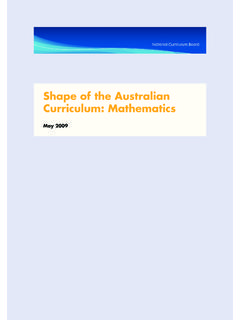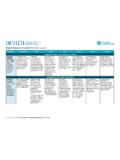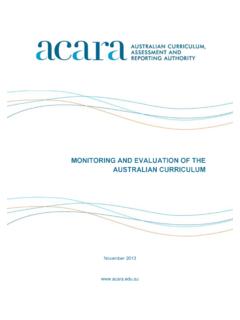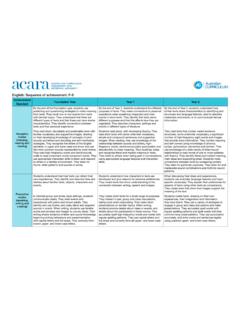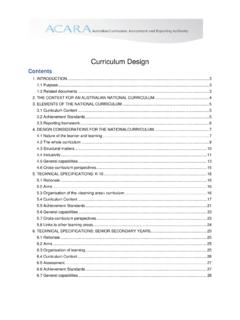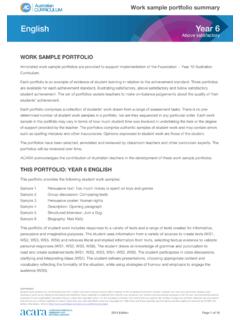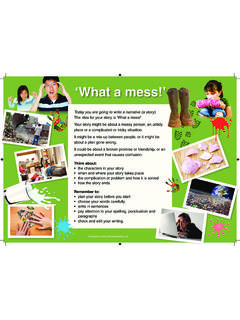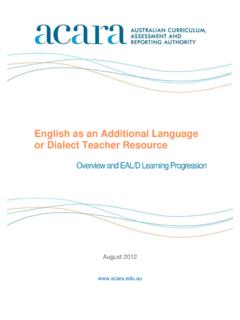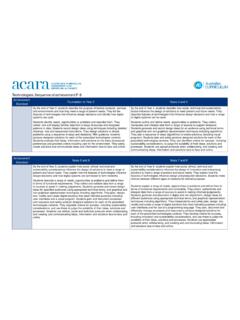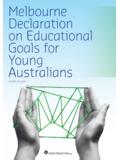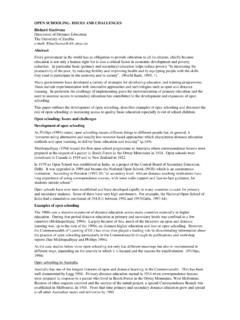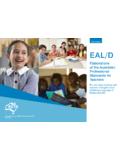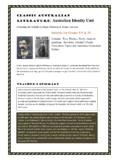Transcription of The Shape of the Australian Curriculum: Technologies
1 The Shape of the Australian 2010 August 2012 Australian curriculum , Assessment and Reporting Authority 2012 This work is copyright. You may download, display, print and reproduce this material in unaltered form only (retaining this notice) for your personal, non-commercial use or use within your organisation. All other rights are reserved. Requests and inquiries concerning reproduction and rights should be addressed to: ACARA Copyright Administration, ACARA Level 10, 255 Pitt Street Sydney NSW 2000 1 Shape of the Australian curriculum : Technologies Contents Purpose .. 2 Introduction .. 3 Technologies education for diverse learners .. 4 Relationships with other areas of the Australian curriculum .. 5 Aims .. 7 Structure .. 8 Subjects in the Technologies learning area.
2 8 Content structure in the Technologies subjects .. 9 Overarching idea: Creating preferred futures .. 9 Managing projects .. 10 Design and 11 Digital Technologies .. 13 Organisation .. 15 Scope and sequence .. 16 Foundation to Year 8 .. 16 Years 9 to 12 .. 17 Technologies scope and sequence .. 19 General capabilities .. 25 Literacy .. 25 Numeracy .. 25 Information and communication technology (ICT) capability .. 25 Critical and creative thinking .. 26 Personal and social capability .. 27 Ethical behaviour .. 27 Intercultural 27 Cross- curriculum priorities .. 28 Aboriginal and Torres Strait Islander histories and cultures .. 28 Asia and Australia s engagement with Asia .. 28 Sustainability .. 29 Conclusion .. 30 Key terms .. 31 Bibliography .. 35 2 Shape of the Australian curriculum : Technologies Purpose 1.
3 The Shape of the Australian curriculum : Technologies provides broad direction on the purpose, structure and organisation of the Technologies curriculum . It is intended to guide the writing of the Australian curriculum : Technologies from Foundation to Year 12. 2. This paper has been prepared in consultation with the Technologies Advisory Group following decisions taken by the ACARA Board, analysis of feedback from the Technologies National Forum and the Technologies National Panel to the Initial Advice Paper: Technologies (November 2011) and feedback from the national consultation on the draft Shape of the Australian curriculum : Technologies . 3. The paper should be read in conjunction with The Shape of the Australian curriculum It is informed by ACARA s curriculum Design paper and the curriculum Development Process 3 Shape of the Australian curriculum : Technologies Introduction 4.
4 The Australian curriculum : Technologies will Shape the future of Technologies learning in schools, ensuring that all students benefit from learning about and working with the traditional, contemporary and emerging Technologies that Shape the world in which we live. The Technologies learning area draws together the distinct but related subjects of Design and Technologies and Digital Technologies and includes the range of Technologies currently addressed by state and territory curricula. 5. Technologies enrich and impact on the lives of people, cultures and societies globally. It is important that as a nation we make connections between creativity, Technologies and enterprise as a catalyst for twenty-first century innovation. We depend upon Technologies for food and fibre production, communication, construction, energy and water management, health and wellbeing, knowledge creation, information management, manufacturing and transportation.
5 Australia needs enterprising individuals who can make discerning and ethical decisions about the use of Technologies , independently and collaboratively develop innovative solutions to complex problems and contribute to sustainable patterns of living. The Australian curriculum : Technologies has the potential to develop Australia's capacity to creatively respond to our national research priorities, many of which focus on sustainability; and participate in and contribute to a knowledge-based economy. 6. Information and communication Technologies , and social media in particular, have increased the pace of change and transformed learning, recreational activities, home life and work. They have provided new ways of thinking, collaborating and communicating for all ages and abilities. The now ubiquitous nature of digital Technologies resulting from digitisation, the miniaturisation and embedding of microelectronics into a range of products, and wireless networking means that students of all ages and abilities expect to be able to play, learn and study anytime and anywhere.
6 7. New developments in Technologies challenge us to adapt to and critically examine how they influence our ideas, opportunities and actions. Technologies , in both their development and use, are influenced by and can play a role in transforming societies and our natural, managed, constructed and digital environments. All young Australians should develop a critical appreciation of the processes through which Technologies are developed and how they can contribute to societies and cultures. They need opportunities to Shape and challenge attitudes to the use and impact of Technologies by evaluating how their own solutions and those of others affect users, equity, sustainability, ethics, and cultural and personal values. We create, as well as respond to, the designed world in which we live.
7 8. Technologies education uniquely engages students in Technologies processes and production, and design and computational thinking. It helps students to understand the world in which they live as they identify, explore and analyse real-world needs, aspirations and opportunities and play an active role in matters that are relevant to them. Students develop knowledge, understanding and skills in the discriminating, ethical, innovative, creative and enterprising use of a range of Technologies . They learn to create, design, develop and produce innovative technological solutions. They play, 4 Shape of the Australian curriculum : Technologies learn, create and produce (make) using a range of materials, data, systems, tools and equipment throughout their years of schooling . 9. A core dimension of Technologies education is the way students learn to use higher order thinking skills to design and conduct investigations including considering ethics, researching and collecting data; predicting outcomes; trialling and experimenting; and reflecting on, evaluating and validating data.
8 Students develop knowledge and confidence in critically analysing and creatively responding to the challenges of a highly technological future. They manage projects from the identification of needs or opportunities to conception and realisation. 10. Reflecting on learning in Technologies builds students Technologies knowledge and deepens their understanding. Technologies knowledge may be demonstrated by how well a project or task has achieved the brief given to, or developed by, the student. Student choices about effective use of materials, data, systems, tools and equipment can be evaluated using criteria for success and design specifications. 11. The Technologies learning area provides opportunities for students to identify and consider the contribution of designers and technology specialists to the improvement of the quality of life, including personal health and wellbeing, home and family life, the nature of their work, the processes used in specialisations and the importance of teamwork and collaboration.
9 12. Students develop a sense of pride, satisfaction and enjoyment in producing quality solutions that may be both functionally appropriate and aesthetically pleasing. Technologies education satisfies the intrinsic motivation of young people to make learning fun and provides students with skills for constructive leisure activities. Technologies education for diverse learners 13. The Australian curriculum : Technologies is shaped by the propositions that each student can learn and that the needs of every student are important. A comprehensive education in Technologies provides opportunities for students to progress from creative play, through to consolidated skills and the challenges of developing innovations in knowledge. In the first years of schooling , students engage in relatively simple Technologies , project briefs and problems, then demonstrate knowledge, understanding and skills in established processes, and eventually work on technologically complex projects using materials, data, systems, tools and equipment.
10 14. Students in Australian classrooms have multiple, diverse and changing needs that are shaped by individual learning histories and abilities, as well as gender, cultural and language backgrounds and socio-economic factors. The Technologies curriculum will be accessible to all students, enabling equality of opportunity. It will provide the flexibility required to personalise learning and build on each student s needs, strengths and abilities. It will allow teachers to take into account the different rates at which students develop, and ensure that all students have equivalent opportunities and choices in their education. 15. The curriculum will allow for difference in student interests, capabilities and future pathways. It will provide the means to engage every student, enabling them to make active and informed decisions, and equipping them with skills to participate actively in the broader community.
